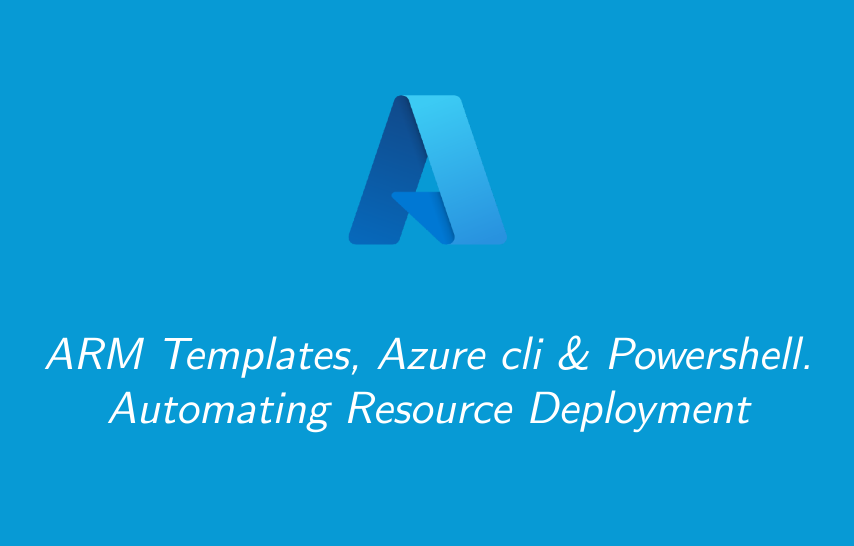As an Azure administrator or cloud engineer, automating resource deployment through Infrastructure as Code (IaC) is essential. Azure Resource Manager (ARM) templates provide a declarative way to describe your infrastructure. In this post, I’ll go through deploying an ARM template using the Azure CLI, covering how to create a resource group and deploy your infrastructure seamlessly.
Quite often during my studies I will want to test around with a topic I am learning and for some reason 3 peered vnets with an NSG on each is something I always end up deploying to play around with. The ARM template I will be using can be found on my github. First you need to login.
az loginThen create the resource group. For this example I used CoreRG for the name and placed it in East US.
az group create --name CoreRG --location eastUSFor me it returns as succeeded.
{
"id": "/subscriptions/74d08291-6d35-4784-b979-73703c8e7063/resourceGroups/CoreRG",
"location": "eastus",
"managedBy": null,
"name": "CoreRG",
"properties": {
"provisioningState": "Succeeded"
},
"tags": null,
"type": "Microsoft.Resources/resourceGroups"
}Then I moved in my terminal to the folder holding my parameters.json and template.json files.
az deployment group create --resource-group CoreRG --template-file template.json --parameters parameters.jsonWhich returns a much larger version of the above.
{
"id": "/subscriptions/74d08291-6d35-4784-b979-73703c8e7063/resourceGroups/CoreRG/providers/Microsoft.Resources/deployments/template",
"location": null,
"name": "template",
"properties": {
"correlationId": "eedabf7e-5a78-4e33-9e3b-10a5ed63e091",
"debugSetting": null,
"dependencies": [
{
"dependsOn": [
{
"id": "/subscriptions/74d08291-6d35-4784-b979-73703c8e7063/resourceGroups/CoreRG/providers/Microsoft.Network/virtualNetworks/eurvnet",
"resourceGroup": "CoreRG",
"resourceName": "eurvnet",
"resourceType": "Microsoft.Network/virtualNetworks"
}
],
"id": "/subscriptions/74d08291-6d35-4784-b979-73703c8e7063/resourceGroups/CoreRG/providers/Microsoft.Network/virtualNetworks/eurvnet/subnets/default",
"resourceGroup": "CoreRG",
"resourceName": "eurvnet/default",
"resourceType": "Microsoft.Network/virtualNetworks/subnets"
},
{
"dependsOn": [
{
"id": "/subscriptions/74d08291-6d35-4784-b979-73703c8e7063/resourceGroups/CoreRG/providers/Microsoft.Network/virtualNetworks/eusvnet",
"resourceGroup": "CoreRG",
"resourceName": "eusvnet",
"resourceType": "Microsoft.Network/virtualNetworks"
}
],
"id": "/subscriptions/74d08291-6d35-4784-b979-73703c8e7063/resourceGroups/CoreRG/providers/Microsoft.Network/virtualNetworks/eusvnet/subnets/default",
"resourceGroup": "CoreRG",
"resourceName": "eusvnet/default",
"resourceType": "Microsoft.Network/virtualNetworks/subnets"
},
{
"dependsOn": [
{
"id": "/subscriptions/74d08291-6d35-4784-b979-73703c8e7063/resourceGroups/CoreRG/providers/Microsoft.Network/virtualNetworks/wusvnet",
"resourceGroup": "CoreRG",
"resourceName": "wusvnet",
"resourceType": "Microsoft.Network/virtualNetworks"
}
],
"id": "/subscriptions/74d08291-6d35-4784-b979-73703c8e7063/resourceGroups/CoreRG/providers/Microsoft.Network/virtualNetworks/wusvnet/subnets/default",
"resourceGroup": "CoreRG",
"resourceName": "wusvnet/default",
"resourceType": "Microsoft.Network/virtualNetworks/subnets"
}
],
"duration": "PT5.866372S",
"error": null,
"mode": "Incremental",
"onErrorDeployment": null,
"outputResources": [
{
"id": "/subscriptions/74d08291-6d35-4784-b979-73703c8e7063/resourceGroups/CoreRG/providers/Microsoft.Network/networkSecurityGroups/eurnsg",
"resourceGroup": "CoreRG"
},
{
"id": "/subscriptions/74d08291-6d35-4784-b979-73703c8e7063/resourceGroups/CoreRG/providers/Microsoft.Network/networkSecurityGroups/eusnsg",
"resourceGroup": "CoreRG"
},
{
"id": "/subscriptions/74d08291-6d35-4784-b979-73703c8e7063/resourceGroups/CoreRG/providers/Microsoft.Network/networkSecurityGroups/wusnsg",
"resourceGroup": "CoreRG"
},
{
"id": "/subscriptions/74d08291-6d35-4784-b979-73703c8e7063/resourceGroups/CoreRG/providers/Microsoft.Network/virtualNetworks/eurvnet",
"resourceGroup": "CoreRG"
},
{
"id": "/subscriptions/74d08291-6d35-4784-b979-73703c8e7063/resourceGroups/CoreRG/providers/Microsoft.Network/virtualNetworks/eurvnet/subnets/default",
"resourceGroup": "CoreRG"
},
{
"id": "/subscriptions/74d08291-6d35-4784-b979-73703c8e7063/resourceGroups/CoreRG/providers/Microsoft.Network/virtualNetworks/eusvnet",
"resourceGroup": "CoreRG"
},
{
"id": "/subscriptions/74d08291-6d35-4784-b979-73703c8e7063/resourceGroups/CoreRG/providers/Microsoft.Network/virtualNetworks/eusvnet/subnets/default",
"resourceGroup": "CoreRG"
},
{
"id": "/subscriptions/74d08291-6d35-4784-b979-73703c8e7063/resourceGroups/CoreRG/providers/Microsoft.Network/virtualNetworks/wusvnet",
"resourceGroup": "CoreRG"
},
{
"id": "/subscriptions/74d08291-6d35-4784-b979-73703c8e7063/resourceGroups/CoreRG/providers/Microsoft.Network/virtualNetworks/wusvnet/subnets/default",
"resourceGroup": "CoreRG"
}
],
"outputs": null,
"parameters": {
"networkSecurityGroups_eurnsg_name": {
"type": "String",
"value": "eurnsg"
},
"networkSecurityGroups_eusnsg_name": {
"type": "String",
"value": "eusnsg"
},
"networkSecurityGroups_wusnsg_name": {
"type": "String",
"value": "wusnsg"
},
"virtualNetworks_eurvnet_name": {
"type": "String",
"value": "eurvnet"
},
"virtualNetworks_eusvnet_name": {
"type": "String",
"value": "eusvnet"
},
"virtualNetworks_wusvnet_name": {
"type": "String",
"value": "wusvnet"
}
},
"parametersLink": null,
"providers": [
{
"id": null,
"namespace": "Microsoft.Network",
"providerAuthorizationConsentState": null,
"registrationPolicy": null,
"registrationState": null,
"resourceTypes": [
{
"aliases": null,
"apiProfiles": null,
"apiVersions": null,
"capabilities": null,
"defaultApiVersion": null,
"locationMappings": null,
"locations": [
"westeurope",
"eastus",
"westus"
],
"properties": null,
"resourceType": "networkSecurityGroups",
"zoneMappings": null
},
{
"aliases": null,
"apiProfiles": null,
"apiVersions": null,
"capabilities": null,
"defaultApiVersion": null,
"locationMappings": null,
"locations": [
"westeurope",
"eastus",
"westus2"
],
"properties": null,
"resourceType": "virtualNetworks",
"zoneMappings": null
},
{
"aliases": null,
"apiProfiles": null,
"apiVersions": null,
"capabilities": null,
"defaultApiVersion": null,
"locationMappings": null,
"locations": [
null
],
"properties": null,
"resourceType": "virtualNetworks/subnets",
"zoneMappings": null
}
]
}
],
"provisioningState": "Succeeded",
"templateHash": "14500970795918664690",
"templateLink": null,
"timestamp": "2024-09-15T23:46:33.141517+00:00",
"validatedResources": null
},
"resourceGroup": "CoreRG",
"tags": null,
"type": "Microsoft.Resources/deployments"
}
We can now see everything we just deployed by running the next command
az resource list --resource-group CoreRG --output tableWhich returns the following:

And checking Azure Portal you can see it as well.

And if you go to deployments you can see that it used our file called template.

To clean this up we can simply run this command:
az group delete --name CoreRG --yesIt took about 5 minutes to run for me.
I also developed a powershell script to automate this for me. You can find the script here along with the ARM template. I’ll also paste it below:
#Import The Module
Import-Module az
#Prompt User For Command
$deployordestroy = Read-Host "Enter command (deploy or destroy)?"
# Check the command entered by the user
if ($deployordestroy -eq "deploy") {
# Get RG Name
$RGname = (Read-Host = "What are we naming the RG?")
$location = (Read-Host = "Where are we deploying to?")
#Prompt for Login
az login;
#Create RG
az group create --name $RGname --location $location
#Deploy template (#vnets and nsg's)
az deployment group create --resource-group CoreRG --template-file ~/Documents/ExportedTemplate-CoreRG/template.json --parameters ~/Documents/ExportedTemplate-CoreRG/parameters.json
#Show the deployed resources
az resource list --resource-group CoreRG
}
elseif ($deployordestroy -eq "destroy") {
$RGname = (Read-Host = "Name of resource group to be destroyed.")
az group delete --name $RGname --yes
}
else {
Write-Host "Invalid command. Please enter 'deploy' or 'destroy'."
}
Here is a snippet of it in action:

And then again to destroy when I am done with testing… (I renamed the file to DeployOrDestroy.ps1 and I have some really cool ideas for this in the future)

That was actually alot of fun and really interesting. Probably because at the same time I was watching my Cowboys get slaughtered by New Orleans. Nonetheless! Please lets talk about this! Leave a comment at the bottom!

